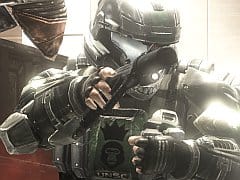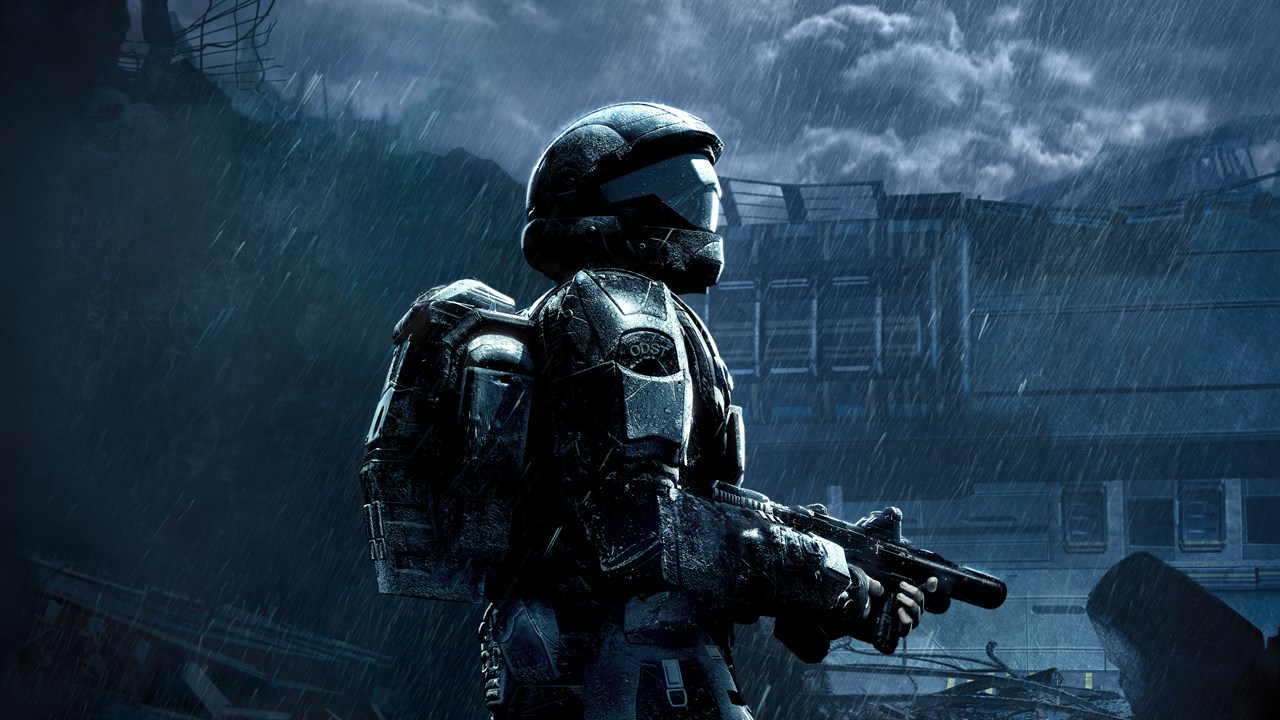You can trust VideoGamer. Our team of gaming experts spend hours testing and reviewing the latest games, to ensure you're reading the most comprehensive guide possible. Rest assured, all imagery and advice is unique and original. Check out how we test and review games here
Halo 3: ODST might be an expansion, a spin-off, it might not be Halo 4, but it’s still a brand new Bungie-developed Halo game. Bungie + Halo commands attention. Bungie + Halo swells anticipation glands. Bungie + Halo dribbles spit. As we walk along Shaftesbury Avenue towards The Century Club, the venue hired by Microsoft to show ODST off to UK press, we are all of these things. Our attention is commanded. Our glands are swollen in anticipation. And we’re dribbling. Really.
“Yeah, but it’s just Halo 3 with a few bells and whistles. And it doesn’t even have The Master Chief in it.” Stop right there. Yes, ODST uses the Halo 3 engine. Yes, it feels, especially in multiplayer, similar to 2007’s blockbuster, and yes, you can still use a Needler to drop anything that moves in the blink of an eye – if you’re good. But, and this is a big but, it’s open world. OPEN WORLD!
At least in single-player (or four-player campaign co-op, which we were surprised to hear Bungie confirm ODST does have). But we’re not here for the single-player. For more on that, check out Neon’s preview from E3 (in summary, ODSTs are slightly slower and don’t jump as high, use stamina and a health bar instead of a shield, and employ a VISR mode instead of a motion-tracker). We’re here for Firefight.
What is it? Firefight is brand new co-op game mode which allows you to team up with three other ODST players, split-screen, system link and over Xbox LIVE, against never-ending waves of Covenant forces. Think Gears of War 2’s Horde mode in first-person. In the upper left-hand corner is a number – at the start it’s seven – detailing the lives you have left. In Firefight, you share the pool of lives across your team. If someone who’s forgot that there’s no I in team gets himself killed playing Rambo, the entire team suffers. Once gone, the only way to gain lives back is to progress further through the game.
Below the live count are more numbers – set one, round one, wave one. Five waves per round, three rounds per set. Then, below these numbers, a vertical line of skulls is displayed. The first, activated at the beginning of any Firefight game, is always “Tough Luck”, which makes the Covenant harder to kill. At round two Bungie turns on “Catch”, which grants the Covenant unlimited grenades, and the desire to throw them ALL OF THE TIME. At round three “Black Eye” activates. You’ll love this one – the only way to get your stamina back is to melee enemies – always fun when the Hunters come.
Obviously Firefight gets increasingly difficult. And it really never ends, not that we were good enough to prove this claim. The only thing, according to Bungie’s senior designer Lars Bakken, that ends Firefight is you running out of lives.
So, what’s it like to play? We played it for about four hours straight, across three different maps, so feel confident in the following judgement: it feels like Halo 3. Now, before you sharpen your pitch forks and light your torches, this is not meant to be a criticism. Halo 3 is one of the greatest games ever made. Fact. There’s a reason it’s still the most popular game on Xbox LIVE, some two years after it was released. And that reason is, it’s bloody brilliant.
Especially in multiplayer. Perhaps, even, because of multiplayer. And it’s in Firefight that ODST feels most like Halo 3. In the campaign, when you’re skulking about New Mombasa at night as the Rookie, gathering clue objects and going all GTA on the open world city, ODST feels quite unlike any Halo game ever made. Firefight, however, at times makes you forget that Master Chief’s not around.
All the new mechanics are in there – the slower movement speed, the nerfed jumping, the VISR mode, and the new weapons (the new semi-automatic pistol, the M6C/SOCOM, and the suppressed M7S SMG, are just brilliant) – so you’d think that would make for a fundamentally different feel. But it doesn’t. The fact that Bungie felt the ripping of turrets from the ground to use as mobile death-bringers was fun enough to keep in ODST, despite the impossibility of such a feat by a human UNSC solider, is telling.
So, really, you do feel like Master Chief when you’re playing Firefight, even though you’re not the faceless super solider. But this is more in terms of that unmistakeable, fluid Halo movement. It’s the rules of engagement, coupled with the lack of a shield, that makes Firefight an experience that feels fresh.
Take the Security Zone map, one of three playable at the event, as an example. This medium-sized daytime map, set in the wide-open ONI exterior, contains a sheltered area on the top of a hill, with an expanse of green below. That expanse is where the Covenant drop ships lower themselves and, er, drop the Covenant. Thing is, every round there’s a chance that Wraiths might appear – you know, the Covenant tanks that spit out devastating blue plasma every two seconds. Now, if you were Master Chief, you would probably simply run and gun your way towards them, absorbing the rapid fire plasma with your shield, leap on and melee it into oblivion. As an ODST this simply isn’t an option. Without a shield, the plasma fire drops you in seconds. They’re doubly hard because they’re in an open field, making it incredibly hard to sneak up on them. The solution? Get a friend to distract them, run up its arse, leap on and plant a grenade. Then run away. Fast.
Although it was hard to tell from the hands-on because Bungie set a ten minute limit and granted unlimited lives, caution, generally, is the modus operandi. One of the chief reasons Halo 3, indeed the Halo series as a whole, has enjoyed such phenomenal popularity is because it’s more accessible than other FPS games. It’s slow in comparison, encourages running and gunning and, because you’ve got a shield, usually affords players more than a few seconds of play time before they’re fragged into oblivion. You try running and gunning in Firefight, and it’ll be your last fight.
Instead, an interesting push and retreat dynamic rears its head. A Covenant wave will drop off – instead of going in all guns blazing it’s better in the long run to hang back and try to pick enemies off with minimal risk to those precious lives, conserving ammo, which is sparse, along the way. In Security Zone turrets are placed on raised platforms, useful for mowing down the incoming horde Saving Private Ryan style. When the Wraith fire forces you to move, rip the turrets from the ground and use concrete structures for cover, hopefully with a more mobile mate watching your six. If you’re the mobile mate in question, a good tactic for downing multiple enemies at once is to unload the SMG clip then quickly switch to the pistol, zooming in for efficient headshots. It’s good to stick together, rather than run off and do your own thing. Then, when the round is over, new weapons drop and lives replenish. Cue mad rush.
Those of you worried that Firefight might descend into a trial and error frag fest, don’t. The make-up of the waves is not predetermined. Your first wave on Security Zone might drop off two Wraiths – bad luck, basically. The next time it could be one, two or none. But every time enemies are dropped off there’s a chance of Wraiths showing up. It’s like a dice roll from hell.
Not all the maps will see you face off against Wraiths, of course. Crater, a night-time level set in Dare’s (one of the Rookie’s squad mates) sunken crash site, is a small map that emphasises close quarters combat. Covenant arrive through corridors on the left and right of the map, as well as dead ahead. It’s not long before the place is flooded with Grunts, leaping Brutes, Brute Chieftains, the wasp-like Drones, the shielded Jackals and, of course, Hunters. Although Bungie remained tight lipped on the possibility of new enemy types, and the Flood, turning up, we reckon Firefight, at later levels, will present some surprises.
Hardest of all the playable maps was Alpha Site, set in the close quarters ONI interior. Here, frequent Covenant drop offs arrive on three separate balconies. There’s an almost MMORPG boss fight feel to it all – your four-man squad needs to divide its time between them, moving quickly to deal with the Covenant as and when they appear. Simply waiting for them to come to you is futile – if all three drop offs get together, they overwhelm you quickly. What’s constant across all three maps is how quickly it gets very, very hard, even on the normal difficulty. It was a good thing we had unlimited lives, because the Covenant took them from us as if taking candy from a baby. Firefight, clearly, will keep the Halo hardcore happy for months.
And the hardcore will be happy to know that Bungie’s layered on top of Firefight’s gameplay a competitive scoring mechanic. Bungie’s taken the campaign scoring and the medal system from Halo 3 and merged them. Medals pop up on screen as you win them, determined by how spectacular the kill. Whether it’s an EMP overcharge with a headshot, a grenade stick or a Gravity Hammer kill, the flashier the kill, the better the medal, and the associated score multiplier (also affected by the difficulty the map is played on). As you score kills, points flash above corpses – 40, 80 – letting you know what you’ve earned (it’s all very Modern Warfare, actually). The iconic announcer does his thing – “Double Kill”, “Triple Kill”. Co-operation and communication is essential if you want to get on in Firefight, but the desire to get the highest score at the end of it all is always clawing at the back of your mind.
A special mention has to go to the graphics. While Bungie insists the graphical improvements are small, to our eyes ODST looks significantly better than Halo 3. Perhaps, as Lars says, it’s merely a trick of the eye – the artists doing their best to drop jaws with blood red skies, devastated cityscapes and impressive vistas. But we reckon everything’s had a small touch up, however trivial. Even the Fuel Rod looks better. Shame, though, that, like Halo 3, the game won’t display in proper high definition.
In truth, we’re more excited by ODST’s open city campaign than we are in Firefight, because that’s where the game will feel most fresh. But Firefight is guaranteed to see more than its fair share of playtime in the VideoGamer.com Xbox 360 – it’s arguably the only thing missing from the Halo experience. Put simply, it’s just fantastic fun. It’s very different, yet unmistakeably Halo. ODSTs move and shoot like Spartans, but in Firefight the rules of engagement are very, very different. Like the announcer says: “Set start. Tough Luck on.” Bring it on.
Halo 3: ODST will be released exclusively on Xbox 360 on September 22.
Halo 3: ODST
- Platform(s): PC, Xbox 360, Xbox One
- Genre(s): Action, First Person, Shooter

/https://oimg.videogamer.com/images/3cf2/halo_3_recon_21.jpg)
/https://oimg.videogamer.com/images/f6ca/halo_3_recon_14.jpg)
/https://oimg.videogamer.com/images/213f/halo_3_recon_16.jpg)
/https://oimg.videogamer.com/images/a481/halo_3_recon_25.jpg)
/https://oimg.videogamer.com/images/8e5d/halo_3_recon_7.jpg)






